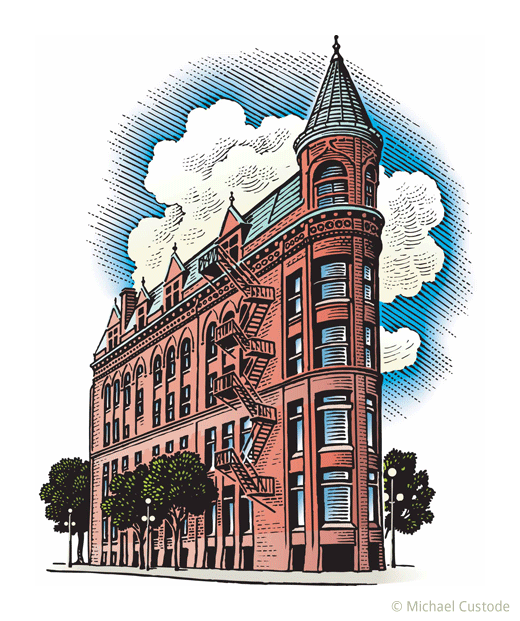Visiting the Gooderham Building: Weather and the Best Days to Explore It.: Seasonal Weather and Nearby Attractions Can Enhance Your Trip.
Visiting the Gooderham Building: Weather and the Best Days to Explore It.: Seasonal Weather and Nearby Attractions Can Enhance Your Trip.
Blog Article
Discover the Rich History Behind the Gooderham Structure in Toronto
The Gooderham Building, an exemplary symptom of Richardsonian Romanesque design in Toronto, has a fabled past that expands beyond its striking red brick frontage. Appointed by the significant Gooderham and Worts distillery in 1891, this building has played an essential function in forming the urban landscape of the St. Lawrence Market area.

Origins of the Gooderham Structure
Building a long lasting heritage, the Gooderham Structure, likewise called the Flatiron Structure, emerged as an icon of Toronto's architectural evolution in the late 19th century. The structure's beginnings trace back to 1891 when it was appointed by the Gooderham and Worts distillery, one of copyright's biggest distilling companies. Designed by engineer David Roberts Jr. Gooderham Building address., the structure was distinctly positioned at the junction of Front and Wellington Streets, making use of a triangular great deal developed by the convergence of these highways
The building's building and construction utilized neighborhood red brick and terracotta, developing an unique visual that matched the expanding cityscape. Originally planned to house the Gooderham and Worts offices, the structure represented the success of the distillery, which had ended up being a significant contributor to Toronto's economic situation. Significantly, the conclusion of the Gooderham Building corresponded with a duration of rapid urbanization that identified the era.
The establishment of this architectural treasure not only showcased cutting-edge design however additionally prepared for future developments in Toronto. Today, it stands as a testimony to the city's abundant background and flexibility, proceeding to attract site visitors and admirers from around the world.
Architectural Value
The architectural importance of the Gooderham Building prolongs beyond its distinct flatiron form, showing the cutting-edge spirit of late 19th-century design. Completed in 1892, the structure exemplifies the Richardsonian Romanesque design, identified by its durable stonework, rounded arcs, and complex outlining. The bold use contrasting products, especially the warm red brick and limestone accents, enhances its visual charm and demonstrates the craftsmanship of the era.
The structure's three-story layout is noteworthy for its harmonious proportions and stylish cornice, which contribute to its renowned silhouette against the Toronto skyline. The narrow whole lot on which it stands presented special obstacles, yet the engineers, in this instance, made a framework that maximized the offered area while preserving aesthetic equilibrium.
In Addition, the Gooderham Structure is a testament to the versatility of architectural design in city settings. Its enduring presence amidst modern developments highlights the worth of protecting historical architecture as a way of recognizing a city's past. Today, it stays a precious site, reflecting both the building patterns of its time and the developing narrative of Toronto as a vibrant urban facility.
Function in Toronto's Advancement
Arising as an essential gamer in Toronto's urban landscape, the Gooderham Structure contributed significantly to the city's growth during the late 19th century. The building was originally made to serve as a storehouse for the Gooderham and Worts distillery, which was one of the biggest distilleries in the British Empire.
As the city expanded, the Gooderham Structure became a crucial part of the St. Lawrence Market area, which was a hub of trade and business. Its unique architectural style and noticeable presence drew interest, affecting the design of subsequent buildings around. Moreover, the building's survival with different economic shifts and metropolitan growths mirrors the resilience and adaptability of Toronto's historical landscape. Basically, the Gooderham Structure is not simply a building spots; it played a crucial duty fit Toronto's identification and financial development throughout a transformative duration in its background.
Social Influence and Heritage
Gooderham Structure's unique architectural design and historic relevance have actually left an indelible mark on Toronto's cultural landscape. As one of the city's most recognizable spots, its one-of-a-kind flatiron form and elaborate brickwork exemplify the Victorian architectural trends of the late 19th century. This framework not only functions as an aesthetic support in the St. Lawrence community however also embodies the spirit of a growing city during a period of economic development.
The structure has actually ended up being a symbol of Toronto's rich history, motivating neighborhood artists and professional photographers who look for to catch its charm. Its visibility has fostered a feeling of neighborhood identity, adding to the narrative of city advancement. Additionally, the Gooderham Building has actually played a read review critical role in the tourist sector, bring in visitors excited to explore its fabled past and architectural appeal.
In enhancement to its aesthetic appeal, the structure encapsulates a story of resilience and adaptation, as it has actually transitioned via different usages over the years - Gooderham Building address. Hence, the Gooderham Building stands not just as a monument of building value however additionally as a testament to the progressing social heritage of Toronto

Repair and Conservation Efforts
Various restoration and preservation initiatives have actually been embarked on to make certain the Gooderham Structure stays an important part of Toronto's building heritage. Initially completed in 1892, the building has actually undertaken substantial restorations to attend to structural concerns while retaining its historic stability. The most notable reconstruction happened in the late 20th century when the building was diligently refurbished to meet modern-day security requirements without endangering its original layout aspects.
These efforts consisted of repairing the unique red-brick frontage, bring back the renowned triangular form, and protecting the intricate stonework details. Furthermore, the building's inside has seen mindful updates that appreciate its historical value, making sure that original functions such as wood beam of lights and ornamental moldings are kept.
The Gooderham Structure is currently protected as an assigned heritage residential property under the Ontario Heritage Act, which helps secure it from inappropriate modifications. Community interaction has actually played an important role in these conservation initiatives, with local advocacy teams elevating understanding concerning the building's historical value. As a result, the Gooderham Building stands not only as a practical room yet likewise as a testimony to Toronto's abundant building history and withstanding social heritage.
Conclusion

Please visit one of our local supporters - Gamerama And The Repair Store - Toronto Iphone Repair Shop
Report this page